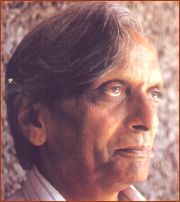 |
  |
 |
  |
SURENDRA MATHUR (1937 - 2001) Ashish Khokar profiles the man he knew for over two decades... e-mail: ashishkhokar@hotmail.com Aug 2001 
Drama was his middle name. Sur-o-mein-inder! That's how he was known in college days as he was a buff of the popular playback singer Mukesh, whom he emulated. But more than music, drama was to dominate this man's life when he moved to Delhi. Born on 29th July 1937 in Moradabad, Uttar Pradesh, he had no artistic background in his immediate environs. But that did not deter him from forming "natak mandali" and making forays into the theatre world. Upon coming to Delhi, he spearheaded the Punjabi theatre movement of the seventies. No, not the Heer Ranjha, Sohni Mahiwal Sheila Bhatia types but the bawdy, boisterous Punjabi plays, of which Chari Jawani Buddhe Noo was a runaway success. So successful was the play that it not only performed over 1000 shows but was made into a full-length feature film which did equally well too. Once, in a boastful mood he asked me: Which play in India has become a successful film too? I'm a pioneer!" Mathur was a bundle of high-voltage energy, never sitting idle on his seat or laurels. His shift from a lowly municipal school of MCD to Secretaryship of Sahitya Kala Parishad itself was nothing short of drama. The then incumbent, a particularly wily character called Sinha, claimed he would make a "donkey the Secretary, but not Mathur" saw Sinha ousted and Mathur in! The reign of Mathur was a boon to arts and artists of not only Delhi but India. Mathur's first task was to shake off the lethargy Parishad had sunk to. Except for some vague Kavi Samellan, once a year at the Red Fort, the Parishad did nothing and had no profile. Overnight Mathur dusted off the cobwebs, shook up his officers and like a magic wand, made the place come alive. First, he won over his immediate bosses, the then CEC of Delhi Jag Parvesh Chandra. Then he worked on and won over all the Chief Secretaries that were the mai-baaps of the Delhi Administration scene. Mathur survived over 5 Chief Secretaries, 3 LG's and 2 CEC's! In a ten year period, this itself was a feat. With such "mandate" and support, he next set out to create and conquer a constituency of artists. He reached out to all and sundry, would drop home, help artists with shows and arrange numerous events. His times saw a never-before activity on the art scene. Even huge bodies, the Sangeet Natak and the ICCR, with hefty budget, could not match Parishad's pelf or profile and outreach. From L. Subramaniam to Penaaz Masani, from Satish Gujral to Narendra Sharma, Mathur had all artists eating out of his palm. He was instrumental in giving several stars of today their initial break. The Singh Bandhus, Ustad Chand gharana, Rajan-Sajan Mishra, Urmila Nagar (as ghazal singer), Deepti Bhalla, Sharon Lowen, O.S. Arun, Rajendra Gangani, Ranjana Gaur, Meenu Thakur to name a few. Countless painters, dramatists, critics, poets, pensioners owe their career to Mathur's initial support. Mathur had humour around him, unknown to him. His mannerisms were comical and he was a master at forging alliances. He often suffered from foot-in-the-mouth disease and once called Sonal Mansingh "celibacy" instead of celebrity! He wondered if Amjad (Ali Khan) would play sarod "in English or Hindi"? On another occasion he desired that all classical forms be combined into one and asked students of Madhvi Mudgal, "why do you keep doing the same mudra, alarripu, moksha...why not combine into one form?". He involved the President of India no less to inaugurate some festivals and coined the term First Lady, when the President could not make it but his best half could. Ministers, politicians, sundry bureaucrats came under his magical spin and he had them where he desired them: to help him to help artists. At Parishad, he created several novel schemes and festivals like Youth Festival, Ghazal Festival, Videshi Kalakaar Festival, Ballet Festival, summer camps, winter shelters, collaborations, et al. Mathur was a magician at heart and his hands often flew like one! All good things must come to an end someday and so he had to retire from the Parishad. But did that stop him? No, he was soon appointed as a Cultural Advisor to ICCR courtesy Vasant Sathe, an enlightened rasika. Mathur made Azad Bhawan the focus of activities and soon there were sounds of guitar, sitar, drums and drama emanating out of it. Next stop, the Congress Cultural Cell (whatever that be!) and Sheila Dikshit's election campaign and upon her victory, an office for Mathur at the Congress Party Office! From there to NDMC was a short, swift move and the unused parks and stadiums of NDMC were now witnessing Morning Ragas and Evening Blues! And all that he left behind, the Parishad (lies in shambles), the ICCR hall (defunct) and NDMC (time will tell) now look like have-beens. For, once the spirit is gone, only the shell remains. Mathur did a lot for arts and artists of Delhi, nay, India. He did not know the difference between sitar and sarod but it made no difference to his enthusiasm, which was infectious. He is survived by his fine wife, Manju, two sons and three grandchildren. His work is his legacy. His soul cannot rest at peace; even up there now he would be cajoling the gandharvas and apsaras to get organised for a concert to be arranged by him! Bless him. Surendra Mathur will be missed for long and thus live on. |